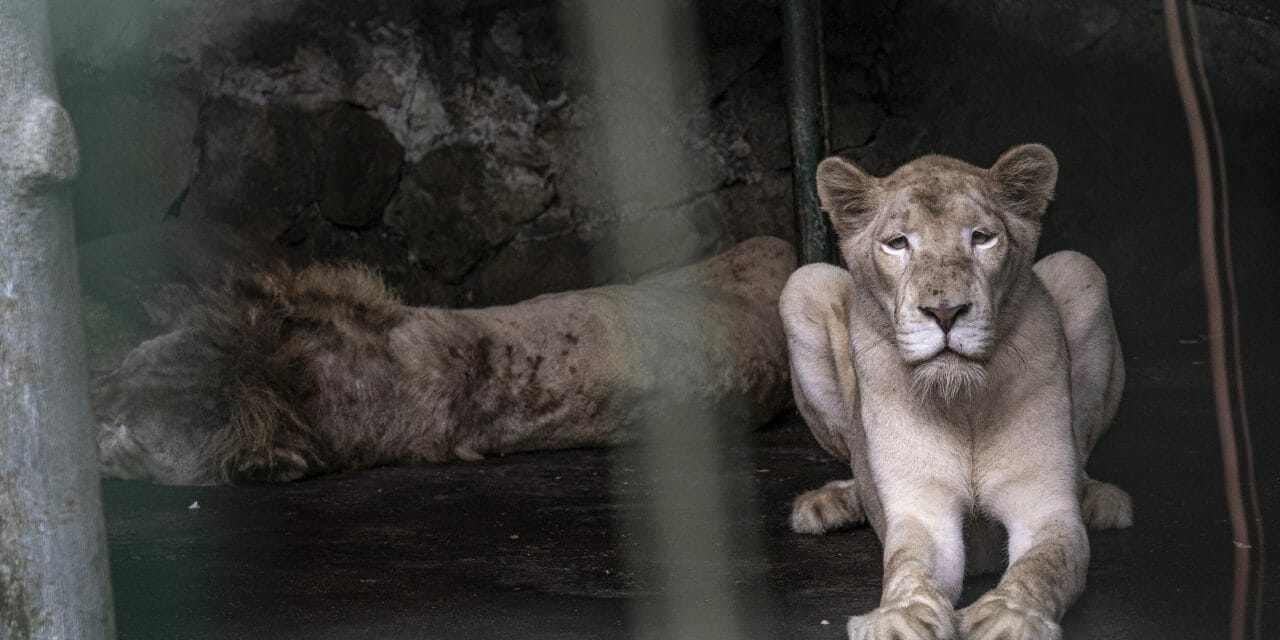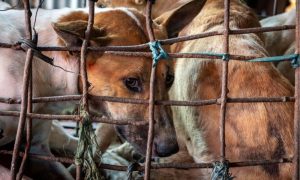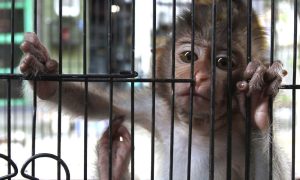A dead crocodile and the heads of three other animals mounted on a board greet visitors near the Lyger Sanctuary, a local zoo in the Philippines.
The bulletin’s border, in blaring red and white, declares the former zoo residents, “Victims of pandemic and typhoon,” with animated, crying zoo animals peeking out from a poster tacked nearby asking people to “Donate to help survivors!”
The Philippines, like the rest of the world, has been hit hard by the COVID-19 pandemic, with communities under a government-mandated General Community Quarantine (GCQ) in August, with the Centers for Disease Control and Prevention ranking the country as Level 3 — or having a “high” number of cases.
In addition to sickening close to 2 million Filipinos and killing a reported 33,000 people as of the end of August, the virus also has slashed profits from tourism — with close to 90% of businesses reporting an anticipated loss of more than half of what they made in 2020, according to a report from the Philippines Department of Tourism.
That financial decline from tourism, as well as a typhoon that ravaged the area, has had sometimes deadly implications for animals imprisoned in local zoos, many of whom — like Lyger Sanctuary — have put out desperate fundraising appeals to the community to help feed and care for their animals.
An undercover investigation, sponsored by Lady Freethinker, revealed seemingly sick and starving animals at five popular Philippines zoos, with malnourished big cats in filthy and inadequate enclosures and animals of several other species — including macaques, civets, a sunbear, and orangutans — demonstrating symptoms of zoochosis, or extreme psychological distress.
But the investigation also revealed problems extant pre-COVID-19, including inadequate enclosures and promoted visitor-wildlife interactions where animals were forced to perform in magic shows or serve as “selfie” props for smiling tourists.
The undercover investigation revealed:
- Malnourished big cats living chained in filthy, inadequate enclosures and used as photo props, and macaques and other animals in small cages, at the Lyger Sanctuary in Pililla
- Malnourished, chained big cats pacing in circles inside inadequate enclosures and chained tigers forced to act as “selfie” props at Zoobic Safari in Bataan
- A malnourished, young tiger attempting to eat a loose nail in his small and inadequate enclosure, civets and other animals imprisoned in filthy and rusty cages without access to clean food and water, and forced photo opportunities with a snake and captive tigers at Zoocolate Thrills in Bohol
- A chained tiger and other animals pacing inside barren cells, two extremely thin lions kept in a filthy enclosure with a small amount of slimy green water within their pond, and advertised animal performance shows at Zoori Residence Inn in Tagaytay
- A pacing sunbear and nonresponsive orangutan, reptile residents in filthy water, and possibly harmful promoted visitor-wildlife interactions at Avilon Zoo in Rizal.
Before the COVID-19 pandemic, the five zoos collectively housed at least 3,326 animals, as per numbers reported on their online pages or in descriptions of the animals they had on exhibit. At the time of the pandemic, LFT’s undercover investigator documented at least 98 animals living in inadequate conditions.
The zoos did not respond about these documented conditions prior to publication of this story.
Several of the zoos — including Lyger Sanctuary, Avilon Zoo, and Zoobic Safari-Zoomanity — are members of the Philippine Zoos and Aquarium Association (PHILZOOS), a nonprofit founded in 2010 with goals to build conservation awareness and to inspire and uphold acceptable animal welfare standards across zoos and aquariums in the Philippines.
PHILZOOS Executive Secretary Noel Rafael said that concerns about the seemingly inhumane and unsanitary conditions at the five zoos, outlined by LFT in a letter sent to the organization, were not new.
“This is not the first time we’ve received reports of such nature,” he said via email. “Rest assured that those cases are being monitored, with most in the process of being properly addressed (albeit gradually) by the involved institutions, and with the aid of PHILZOOS.”
All of the zoos in this report had put out public fundraising appeals to the surrounding communities to help them care for and feed their animals. Meanwhile, they’ve kept their idyllic-appearing exteriors — with the entrance of Zoobic signing in large letters “The Happiest Places!” with statues of exotic animals surrounded by lush greenery.
The animals in the barren enclosures within tell a much more dismal story.
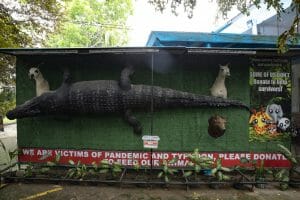
Dead animals mounted near Lyger Sanctuary (Image via undercover investigation)
Sick and Suffering Animals
Visitors typically can gain access to the five zoos covered by the LFT undercover investigation for entrance fees ranging from 200 to 800 Philippine pesos — the equivalent of $4 to $16 USD.
PHILZOOs members suspended tourism operations when the Philippines government imposed community quarantine in March 2020, Rafael told LFT.
He added that since most members are privately owned — meaning they don’t receive funds from the government — they “faced real challenges due to lack of income and depleting resources.”
Online fundraising appeals for donations and pre-paid tickets helped zoos pull through the end of the first quarantine, with limited tourism operations picking back up in October 2020, Rafael said.
The fundraising appeals, including by the Zoomanity Group — which operates Zoobic, Zoori, and Zoocolate — also picked back up when the government instituted another community quarantine this year.
“During quarantine period, Zoomanity Group and all its parks and zoos sees to it that we provided and take care of all the needs of our animals under our protection and management,” the group said in a Facebook fundraising appeal. “But as this challenging time stretches, best effort we want to continuously give quality life and environment for our animals, and WE NEED YOUR HELP to achieve this.”
Avilon Zoo put out a similar message.
“While under quarantine, we in Avilon Zoo exert our best effort to provide for the needs and welfare of all life under our care,” the zoo wrote in a statement calling for community support. “We must admit though that it is quite challenging to maintain good quality animal care and veterinary services in this extraordinary time.”
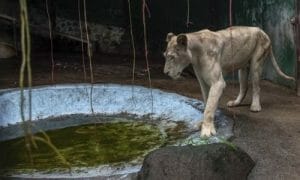
Conditions at Zoori Residence Inn (Image via undercover investigation)
Despite the zoos’ efforts and reassurances, wildlife experts who reviewed the undercover photos and videos across the five zoos told Lady Freethinker that the animals are clearly and severely suffering.
Marc Bekoff — a professor emeritus of ecology and evolutionary biology at the University of Colorado, an Animal Behavior Society fellow, a Guggenheim Fellow, and a scientific advisor for Voiceless/Australia, told LFT that animals deprived of basic necessities such as adequate and good food, clean water, and space, or needed enrichment and socialization with their own kind, can lead to zoochosis — or repetitive, stress-induced behaviors.
“Generally you can see stereotyped pacing, rocking back and forth, self-mutilation, and hyper aggression,” he said. “Caging them and putting them on display is also cruel from a neural perspective. There can be effects on the brain.”
Bekoff, who viewed one photograph of a lioness near a pool coated in green slime at Zoori at Residence Inn, and one video of a chained white tiger, pacing in tight circles inside an enclosure at Zoobic Safari — described the conditions as “utterly horrific” and alleged they constituted “clear and obvious animal abuse.”
While studies have documented the ill effects of captivity on big cats, Bekoff also noted that animals of many other species also can “literally go crazy.”
“There’s every reason to think that many other animals, regardless of size, also show similar responses to being held captive and losing control of their lives,” Bekoff wrote in an article for Psychology Today.
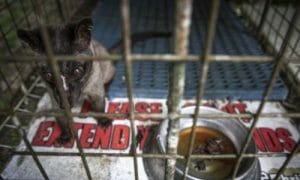
Conditions at Zoocolate Thrills (image via undercover investigation)
A trail of complaints left by concerned members of the public also indicates problems existed before COVID-19.
Avilon Zoo has made World Animal Protection’s list of venues to avoid until management “drastically improves animal welfare,” with media coverage from National Geographic noting the zoo used to dress up and promote primates being used as photo props — although the zoo has since stopped those interactions.
Zoobic Safari was accused by a citizen of drugging tigers in the past so that people could pose with them, according to GMA News Online. A Change.org petition from 2014, which was signed by more than 1,700 people, also alleged that lions and tigers were kept in inadequate enclosures, including some left without water.
One Trip Advisor viewer alleged in 2017 that Lyger Sanctuary is not an actual sanctuary, calling the situation “heart breaking” and noting animals in small cages and enclosures that didn’t allow them to socialize properly.
Inhumane and Unsanitary Conditions
Animal welfare regulations for zoo animals are outlined in the Philippines’ Animal Welfare Act of 1998, as amended in 2013.
That law recognizes animal sentience and also requires that animals be free from fear, distress, harassment, and unnecessary discomfort or pain — including that animals must be provided with adequate care, sustenance and shelter — and requires that animals be able to express normal behavior.
Governmental agencies have authority to impose fines or imprisonment in proven cases of animal cruelty, and zoos can have their government-mandated registrations revoked should animal suffering be proven within their establishments.
Georgia Mason, the director of the Campbell Centre for the Study of Animal Welfare, reviewed one of the undercover videos of a tiger chained at Zoobic Safari.
“Many things are very concerning about the animal’s behaviour in this video: that the tiger is constrained with a chain, the animal’s stereotypic pacing (always a sign of poor welfare), and the uneven gait that indicates a medical condition,” she wrote via email.
Patricia Tricorache, an illegal wildlife trade expert who also works at Colorado State University’s Natural Resource Ecology Lab who viewed photos and videos spanning the five zoos, told LFT that several of the animals appeared “malnourished” and that the animals’ enclosures “seem completely inadequate in terms of size and set up.”
“Those animals that in the wild would roam for quite long distances have nowhere to go, nowhere to climb or hide,” she said. “The only enclosure that seems larger is the sun bear’s, although it doesn’t seem to get any sunlight.”

Conditions at Avilon Zoo (image via undercover investigation)
She also had concerns about the enclosure of Zooco, marketed as the Philippines largest captive snake by Zoocolate Thrills, saying the snake — often used as a photo prop — “has apparently nowhere to climb and probably not much sunlight, which cold-blooded animals require.”
“Also, some of those animals are too close to one another, like the leopard and puma at the Avilon Zoo,” she added. “This usually causes tremendous stress.”
The photos and videos of conditions across zoos also showed no bedding for animals, dirty drinking water, and dirty water within turtle enclosures, Tricorache said. She added that conditions were so bad at the zoos that they should be shut down and the animals relocated.
“From looking at the videos and images, I see no way they can improve the way they keep the animals or the activities they encourage,” she said. “The animals should be taken to sanctuaries or euthanized if it’s a better option for the very sick ones. And any penalties should be applied.”
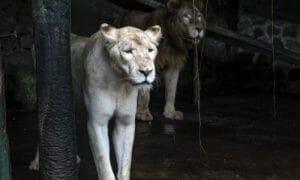
A lion and lioness at Zoori at Residence Inn (image via undercover investigation)
Captive Big Cat “Selfies,” Forced Photo Opps, and Conservation Messaging
Scientific studies into zoo animal behavior have documented that forcing interactions between humans and wildlife can cause significant stress and physical and psychological damage.
All of the zoos covered by the LFT undercover investigation offered promoted, paid photo opportunities with animals.
Zoobic’s website shows that up to six tourists can pose at one time with a chained tiger for between 240 and 540 Philippine Pesos (the equivalent of about $5 to $10 USD) — an “opportunity” that includes hands-on contact and feeding the big cat a white fluid in a baby bottle, as evidenced in the photo documentation. Visitors also can buy chickens to directly feed to tigers and crocodiles for P50 to P200 ($1 to $4 USD)

Tourists pose with a chained captive tiger at Zoobic Safari (image via undercover investigation)
At Zoori, up to four tourists can crowd around a chained tiger for between 240 and 360 Philippine Pesos (the equivalent of about $5 to $7 USD), according to the zoo’s website.
By contrast, Zoocolate allows photo opps with unspecified “live animals” for as little as 20 Philippine pesos — the equivalent of $0.40 USD. The zoo also allows visitors to purchase “animal chow” or chicken feedings for P20 to P100 ($0.40 to $2 USD, respectively).
Avilon Zoo’s and Lyger Sanctuary’s prices were not listed online for their photo opportunities with live animals.
PHILZOOS, the Philippines-based zoos and aquariums organization, belongs to the umbrella organization Southeast Asia Zoos & Aquariums Association (SEAZA), which in turn is a regional member of the World Association of Zoos & Aquariums (WAZA).
WAZA’s animal welfare guidelines note that zoos should not involve captive animals in any interactive experience that would compromise their welfare and that animals should have the choice of participating in those interactions. The guidelines also say animals should never be portrayed as “pets” or “performers” and that any messaging related to visitor-wildlife interactions should have conservation at its core.
All WAZA members will need to comply — without compromise — to WAZA’s guidelines by 2023.
None of the five Philippines’ zoos in this report are WAZA members, a spokesperson told LFT. A World Animal Protection report also noted that the concept of animal welfare in the Philippines — although of growing importance to members of the public, government officials, and legislators — is lagging.
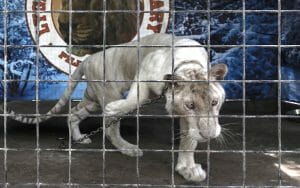
Photo from Lady Freethinker investigation
The slowly-growing awareness about animal welfare and animal behavior shows in some of the documented videos and photos and the zoos’ responses to them.
An Aug. 21 video of puma Adidas, manically pacing from one end of the enclosure to the other, was posted and tagged by Lyger Sanctuary as a “Wonder Video” and captioned: “Where are all the people? Our Puma named ‘Adidas’ is longing for your visit at Lyger Animal Sanctuary.”
Several scientific studies note pacing in carnivores is a symptom of extreme psychological stress — not a desire for human interaction.
Messaging by the Zoomanity Group also highlights the “thrill” and “adventure” of being close to wild animals over respect for the animals or their wellbeing.
Zoobic advertises its “Croco Loco” — an attraction where visitors can walk over a steel grated walkway above a reported “over 200 crocodiles” — characterizes a crocodiles as a “snapping monster directly below you.”
Messaging of tiger photo opps and the Tiger Safari — in which captive big cats jump on top of a Safari vehicle or eat chicken through the bars of the windows — is billed as “an adventure like no other here in the country: a close encounter with the biggest members of the cat family.”
“See the amazingly long and sharp tiger-canine teeth so close to you that you actually feel the fear and excitement of these ferocious hunters,” the zoo wrote on its website. “Thrill as a 400 pound tiger easily jumps on top of your safari vehicle while he eats a whole chicken.”
Tigers are kept enclosed in areas “with just inches away” from tourists as well, who are invited to view the big cats “up close in their own sleep and rest area,” according to Zoobic’s website.
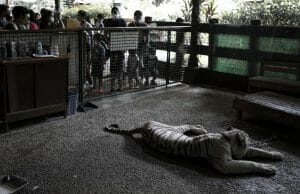
Conditions at Zoobic Safari (image via undercover investigation)
Messaging by Zoocolate, which offered visitors the chance to ride Philippine buffalos pre-pandemic, also shows a lack of awareness of animal welfare while aiming to amp up adrenaline.
“Take a wet and wild ride while sitting at the back of our Philippine buffalos,” the zoo’s marketing states. “Definitely a must try adventure, just like the elephant ride in Thailand.”
Tricorache, the wildlife expert, said the conditions detailed in these interactions — including keeping big cats on chains and hands-on contact– are “unacceptable.”
“Hand feeding an adult tiger milk is not appropriate or healthy, but even worse is having the tiger pose with people for a picture — especially kids!” Tricorache wrote to LFT. “Any of those people could make a sudden move or noise and prompt a bad response from the animal … the same goes for feeding a tiger from a tourist vehicle, since a hand caught by a tiger dewclaw could be very dangerous.”
Tricorache noted numerous studies that have shown that animals can contract COVID-19 from human visitors — or pass the disease to human hosts.
“The closeness of both species should not happen,” she wrote. “I don’t know if there also are human interactions with the primates, but it is well known that primates can transmit zoonotic diseases to humans.”
Tricorache added that while many zoos cover the profit-making interactions under the guise of “conservation,” inappropriate human-wildlife interactions can encourage irresponsible future behaviors — including viewing wild animals as human-friendly or as possible “pets.”
“Encouraging such interactions with children can make kids lose awareness of the fact that these animals are wild,” she said. “Exotic pet ownership is probably a desire that is born from having such interactions since they grow up thinking that it is OK to hold these animals prisoners.”

A tiger chained at Zoobic Safari (image via undercover investigation)
What Happens Next?
The professional perspectives of the wildlife experts who viewed documentation of conditions at the zoos said conditions required immediate improvement or animals needed immediately relocated.
“They’re definitely not in compliance with the animal welfare act of 1998, as amended in 2013,” Tricorache said.
WAZA, the global alliance of zoos, said they have no authority to step in to help.
“Unfortunately, we are limited in what we can do, as these zoos are not WAZA members,” the agency told LFT.
Rafael has told Lady Freethinker — and others — that PHILZOOs is taking steps to improve management practices and welfare to meet the WAZA and SEAZA guidelines.
“In an ideal world, there really shouldn’t be zoos,” Rafael said, during a presentation at the SEAZA e-forum in November 2020. “We do not have the right to restrict life. But, zoos are here and the world is a mess, so we have to make the most positive out of that reality.”
PHILZOOs launched an “Animal Welfare Science Workshop Series” in 2019, which invited speakers from Wild Welfare, the UPLB Museum of Natural History, and Wildlife Reserves Singapore to facilitate seminars and technical training for PHILZOOs decision makers and staff.
PHILZOOs also is working with governmental agencies — including the Bureau of Animal Industry and the Biodiversity Management Bureau — to develop welfare standards for Philippines’ zoos, Rafael said.
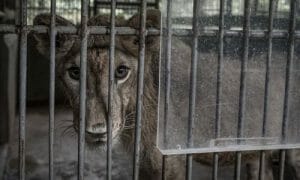
Conditions at Zoobic Safari (image via undercover investigation)
Those guidelines haven’t yet been published, but animal welfare ideals posted on PHILZOOS’s website notes they aim for member facilities to serve as primary centers for conservation, education, recreation and research and to keep and exhibit animals in accordance with established welfare standards.
“Compliance to universal animal welfare standards is a gradual process, especially if socio-economic factors and circumstances beyond our control (pandemic-induced lockdowns and restrictions, natural calamities) come into play,” Rafael told LFT via email. “Despite the challenges, we in PHILZOOS are committed to ultimately provide the best possible conditions for all life under our care. We can achieve that by working together and lifting each other up whenever and however possible.”
Agencies already established within the Philippines — including the Bureau of Animal Industry (BAI), the Department of Agriculture, the Philippine National Police, and the National Bureau of Investigation — also can take action against zoos where animals are suffering, including fines, imprisonment, or relocation of animals to vetted sanctuaries, as established in Philippines law.
There also are many glimmers of hope for animals that indicate the country cares about animal welfare and could be poised to take immediate action to improve the situation– and not just for animals in these five zoos.
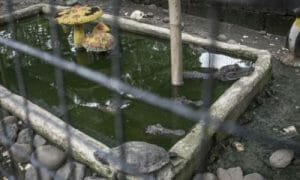
Conditions at Lyger Sanctuary (image via undercover investigation)
The country has celebrated “Animal Welfare Week” the first week of October since 2004, by Presidential proclamation.
Three governmental departments — the Department of Ag, the Department of Health, and the Department of Interior — as well as local government all have pledged support for the Universal Declaration of Animal Welfare, according to a report from World Animal Protection.
Representatives from the BAI and the Philippines Biodiversity Management Bureau also met with a wild animal welfare nonprofit in 2020 to discuss improving the zoo accreditation process.
There also is the Filipino community, which has stepped up to support zoo animal welfare during the crush of the COVID-19 pandemic.
Meanwhile, Lady Freethinker will do all we can to help these suffering animals into better conditions.
Sign our petition demanding a thorough investigation into conditions at these five zoos as well as an immediate end to inhumane photo opportunities with captive wild animals.
SIGN: Justice for Sick and Starving Animals Exploited for ‘Selfies’ at Horrific Philippines Zoos

